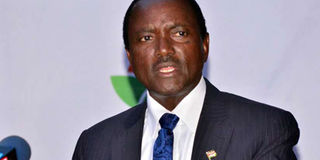Nasa election promises are unworkable

National Super Alliance co-principal Kalonzo Musyoka addressing the media at the coalition's offices on July 13, 2017. Nasa says it will build county and rural roads. PHOTO | FRANCIS NDERITU | NATIO MEDIA GROUP
What you need to know:
- The manifesto is not only unworkable, but could also plunge the country into economic collapse.
- An upsurge in borrowing will trigger a big rise in interest rates.
The National Super Alliance (Nasa) has evaded all attempts to pin it down to give details on how it plans to implement its election manifesto beyond the outsized promises.
Government granaries overflowing with food stocks, cheap housing, water, roads and airstrips in all the counties are among the undertakings it gives.
Superhighways will run from Mombasa to the Malaba border, and the northern circuit will be linked by tarmac road from Moyale through Mandera to Wajir and Garissa.
FUNDING
Counties will get 45 per cent of national revenues, secondary school education shall be free and every Kenyan will have health insurance.
The coalition says it will reduce the cost of living, raise salaries, bring down the public debt and grow the economy by 10 per cent every year.
Dr David Ndii, an economist and Nasa adviser, failed when he was given an opportunity on TV, to give specifics on implementation.
ECONOMY
The manifesto is not only unworkable, but could also plunge the country into economic collapse.
Implementing the projects will balloon the budget, increase the deficit and force the government to borrow even more money domestically, locking out private households and businesses from accessing loans.
Going by the cost of infrastructure projects, it is easy to deduce the likely impact of the promises on the national Budget.
ROADS
The Jubilee government, for instance, has already pencilled in a dual carriageway from Mombasa to Nairobi at a cost of Sh230 billion.
Nasa’s four-lane highway from Mombasa to Malaba could cost about Sh500 billion.
Nasa also says it will build county and rural roads, a high-speed commuter railway in Nairobi, inland water transport, Moyale-Mandera-Wajir-Garissa highway, Likoni bridge, a Nairobi mass-transport project, and Lake Victoria ring road.
It will also build or upgrade airstrips in county headquarters. The total cost would come to Sh1.3 trillion over five years!
SALARIES
Yet it has committed itself to allocating 45 per cent of national revenue to counties annually.
It will also increase wages for security forces, teachers and other public servants.
National revenue now stands at 19.2 per cent of the GDP or Sh1.7 trillion.
By 2022, it is expected to rise to Sh2.8 trillion or 19.9 per cent of the GDP.
DEFICIT
A Nasa budget would balloon from Sh2.8 trillion this year to Sh4.5 trillion by 2022.
This will leave a hole in the budget that starts at Sh1.1 trillion this year, rising to Sh1.7 trillion in 2022.
The deficit this financial year is only Sh532 billion.
PUBLIC DEBT
Yet, Nasa claims the public debt is unsustainable, and if elected, will seek to reduce it.
Just on these projects alone, the debt could skyrocket from Sh4 trillion to Sh12 trillion in five years, or 84 per cent of GDP!
Out of every Sh10 generated, Sh8 will go to paying debt.
Projections show the domestic debt would rise from Sh268 billion this year to Sh1.2 trillion by 2022.
INFLATION
It is not clear if local investors will fund such a borrowing spree.
First, the huge budget deficit will cause inflation to rise.
Our foreign reserves will be depleted yet in the past nearly five years, they have risen to their highest level of $8.2 billion.
INTEREST RATES
An upsurge in borrowing will trigger a big rise in interest rates.
The government will borrow more expensively.
Individuals and small businesses are likely to be locked out of loans and those who will access them will be charged exorbitant rates.
KRA
The stable 14 per cent rate borrowers are enjoying will disappear.
Just to meet some of these obligations, Kenya Revenue Authority will need to collect at least Sh260 billion in VAT annually.
To achieve this, Nasa will have to raise the VAT rate from 16 per cent to 29 per cent.
Mr Nabea is a security consultant and political commentator. [email protected]




